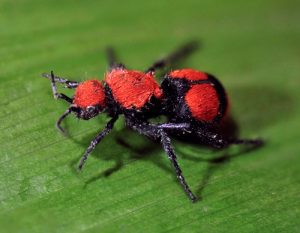Don’t Touch the Velvet Ant!
By Chris Williams on February 2, 2012.
Why shouldn’t you touch a velvet ant? Because, despite its name, it’s not an ant at all, it’s a wasp. That should give you a clue. Like other wasps, it has a stinger and can inflict a painful sting. The velvet ant is sometimes called the “cow killer” because it was thought its sting could kill a cow! The sting can’t kill a cow or a human, and it’s not poisonous, but it sure hurts like heck.
The velvet ant is shaped like an ant but is really a wingless female wasp. The male velvet ant has wings, is rarely seen, and doesn’t sting. The female velvet ant attracts attention, especially from kids, because she is colorful and fuzzy. She begs to be petted. Velvet ants are usually a combination of orange, red and black hairs in bands. They’re similar in coloration and fuzziness to wooly bear caterpillars but pack a lot more wallop if handled. Adults can be fairly large, up to 7/8 inch long.
 Velvet ants are most common in southern and western states, but they do occasionally occur in our Northeast area. They’re found outdoors, mostly in dry, open sandy areas (the same areas where you find ground bees) where they run erratically on the ground. They’re generally considered to be beneficial because the female lays her eggs in the nests of ground-nesting bees and wasps. Her larvae then feed on the pupae of those bees or wasps. Some species are thought to dig nests in soil and provision them with insects for their larvae, while others reportedly prey on honey bees. Adult velvet ants feed on nectar.
Velvet ants are most common in southern and western states, but they do occasionally occur in our Northeast area. They’re found outdoors, mostly in dry, open sandy areas (the same areas where you find ground bees) where they run erratically on the ground. They’re generally considered to be beneficial because the female lays her eggs in the nests of ground-nesting bees and wasps. Her larvae then feed on the pupae of those bees or wasps. Some species are thought to dig nests in soil and provision them with insects for their larvae, while others reportedly prey on honey bees. Adult velvet ants feed on nectar.
You usually only see one velvet ant at a time. They’re solitary wasps and do not live in colonies. But you may find a number of velvet ants where there have been large colonies of ground-nesting bees. On rare occasions, a velvet ant may wander into a home during the summer months. Although the wasps look cuddly, don’t pick one up. People are most often stung when they step on a velvet ant while barefoot. Velvet ants produce a squeaking sound when disturbed. That, combined with their bright coloration, serves as a warning to predators and people to keep their distance!